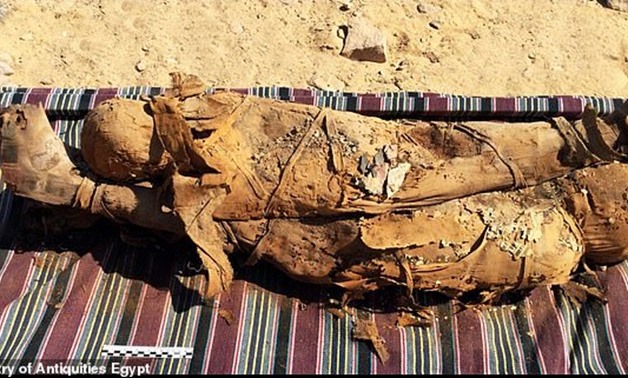
File-uncovered mummies
CAIRO - 29 April 2019:
This mission has discovered till now around 300 tombs in the Aswan West Bank area.
The uncovered tomb contained various artefacts, including a statuette of a bird, various vases, and a stretcher that was probably used to bring mummies into the tomb.
Writing found on parts of a coffin in the tomb showed clearly both a series of prayers to different goddess as well as the name of the tomb's owner Tjt.
Tjt tomb has a main room that housed 30 mummies, including young children who were lying together in a long, sideways alcove.
Archaeological mission head Patrizia Piacentini said that among the mummies were two that were 'superimposed' and thought to be that of a mother and child.
The pair were extracted still covered in painted cartonnage, a type of mummy covering which is formed from chunks of linen or papyrus which have been glued together.
Secretary-General of the Supreme Council of Antiquities Mustafa Waziri stated that a wooden coffin containing hieroglyphic text was found inside the tomb, through which the mission was able to identify the name of the ancient graveyard.
Waziri added that the tomb also contained parts of two painted wooden coffins.
One of the fragmented coffins presented a complete text, detailing the name of the tomb's owner, Tjt, and prayers to the gods of the Nile's First Cataract — Anuket, Khnum and Satet — along with Hapi, the god of the annual Nile floods.
Leaning up against the north wall of the tomb's interior was an intact stretcher which, archaeologists believe, may have been used to bring the mummies into the tomb in the first place.It was made of palm wood connected by linen strips.
Head of the Egyptian Antiquities Department Ayman Ashmawy pointed out that the cemetery consists of a ladder that leads to a side chamber where a rock-cut coffin, a front stone consisting of a group of mummies in a poor state and three nests were found.
The mission also recovered many amphora-shaped jugs, ritual offering vases and some vessels which still contained food.
Vessels containing bitumen that was used in the mummification process, a lamp, and white cartonnage that was ready to be painted were all found near the entrance to the burial chambers.
In addition, the team found many other vividly coloured and gilded cartonnages, parts of gold-painted funeral masks and a well-preserved statuette of a Ba-bird.
In Ancient Egyptian mythology, the Ba-bird represents the soul of a deceased individual, which was believed to fly out the person's tomb to join their vital essence in the afterlife.
Authorities have dated the tomb back to the Graeco-Roman period, which began when Alexander the Great conquered Egypt out from under Persian rule in 332 BC.
The tomb is located near one of Aswan's major landmarks, the Mausoleum of the Aga Khan III, Sir Sultan Muhammed Shah.
This religious leader lobbied for Muslim rights in India, and was buried in Egypt near the sight of his former winter-time villa two years after his death in 1957.
To date, the mission has mapped around 300 individual tombs in the area around the Mausoleum of the Aga Khan.
The tombs all date between the 6th Century BC and the 4th Century AD.
25 tombs have been excavated by the archaeologists in the previous three years alone.

Comments
Leave a Comment